
 |
|
The pianola was not the first machine to automatically play music. “Street pianos”, “barrel organs” and “hurdy gurdies” were common in the 18th and 19th centuries, with mentions of “mechanical pianos” in records as far back as the mid 1500s. Typically these machines were large wooden boxes on wheels with handles on the end, often pulled by a horse. They would travel from county fair to county fair, from market place to market place, or along city streets, where to amuse passers-by the operator would turn a handle, or pump at some bellows, to produce music. |
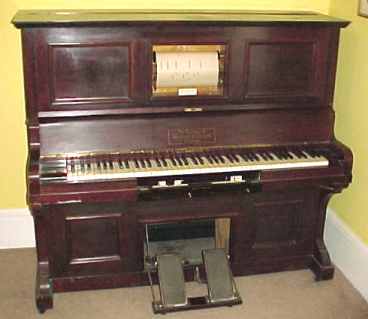 |
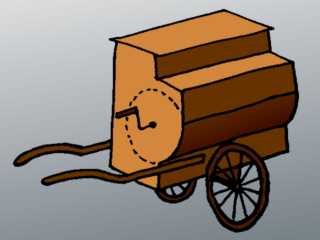 |
The Street PianoThe street piano contained a large wooden barrel with sturdy pins (wooden or metal) in it. Each pin represented a note to be played. Turning a handle on the end of the machine would rotate the barrel, making the pins knock hammers which in turn would strike the piano strings, thus playing the music. Street pianos were characterised by the harsh “honky-tonk” sound that they made. |
The Barrel OrganThe barrel organ used a similar arrangement of barrel and pins to represent the music. However, instead of the hammer and piano strings, the barrel organ contained a series of pipes, and a pair of bellows. The pins in the rotating barrel would open holes in the relevant pipes through which air from the bellows would blow to play the notes, like a church organ. |
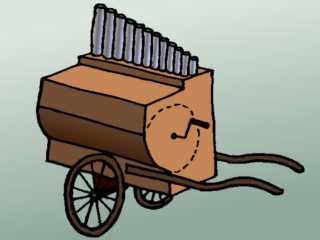 |
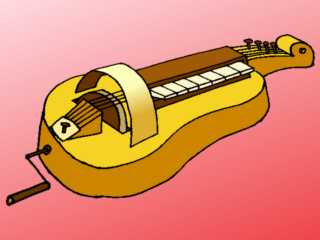 |
The Hurdy-GurdyThe hurdy-gurdy was a very different machine. It contained a group of violin strings, against which a resin-coated wheel was rotated so that the strings played continuously. The operator would press keys on a small keyboard, each key pushing stoppers at pre-set positions against the strings to play different chords. |
|
The principal disadvantage of the street piano and the barrel organ was that to play a different tune, a different barrel was required, but these barrels were large and heavy. While the hurdy-gurdy allowed the operator to make up different tunes, the range of music was limited by the number of pre-set chords on the machine. Thus from the early 1800s onwards, efforts were made to improve the way in which music was stored. |
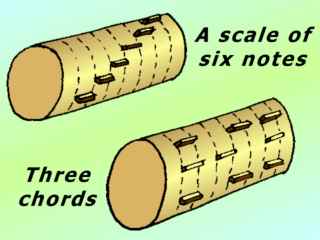 |
At the same time, “player-pianos” (as pianolas were originally known) were also improved to allow more control of the volume of the notes played, and in turn the quality of the sound they made.
The volume control problem was due to the pin, barrel, hammer arrangement described above, being unable to provide controlled energy to strike the piano strings independently of the speed of the music.
To play the notes loudly, the barrel had to be rotated more quickly so that the hammers, knocked by the pins, struck the strings harder. To play the music quietly, the barrel would be turned more slowly. Therefore the volume was directly linked to the speed at which the music was played.
Music Storage ProblemThe music storage problem was that the storage medium had to be resilient enough to withstand the mechanical interactions required to start and stop playing notes. A system in wide use in the mid 1800s was the “zig-zag book” of cardboard sheets, which were fed into the piano player. The cardboard had to be very thick and heavy to be able to knock the hammers without ripping or tearing. |
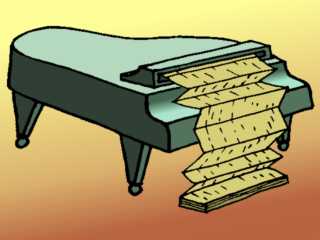 |
The breakthrough to both problems came in the 1880s with the development of the “pneumatic action”.
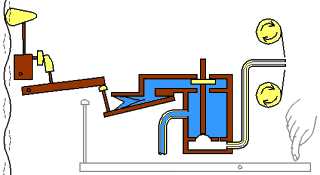 |
Pneumatic ActionPneumatic action relies on the power of air and the forces created by different pressures inside and outside a system of pipes and bellows. Using this system it became possible to strike the piano strings at a volume independent of the music speed, and the music storage device no longer needed to come into direct contact with hammers. Therefore it became possible to use thinner and lighter paper to store the music, and the quality of the sound produced became more refined. |
The 20th CenturyFrom the start of the 20th century pianolas became popular around the world, with numerous manufacturers in the USA, the UK, France, Germany, Russia and even Japan. 2.5 million pianolas were sold between 1900 and 1930 in the USA alone. Concerts where a pianola would accompany a full orchestra were held in London to promote the machine. The number of pianola manufacturers and makers of music rolls in these countries also increased dramatically during this period. A proliferation of mergers and takeovers makes it difficult to know precisely who made what. |
 |
One significant pianola maker was the Aeolian Company in the USA (known as the Orchestrelle Company in the UK) which primarily made 65-note painolas. It made the first grand piano pianola in 1904, and also patented a number of techniques adopted throughout the industry to improve the control of the sound produced.
It made pianola rolls under the tradenames Metrostyle, Themodist and Universal. Other significant pianola makers included the German company Kastner Autopiano (known as Kastner & Co. Ltd. in the UK), and the British company Meloto Co. Ltd., which also made music rolls under the tradename Universal Music Co. Ltd.
The Perforated Music Co. in London was the biggest maker of music rolls in the UK. By 1913 it was producing 300,000 music rolls a year, consuming a ton of paper each week. Unfortunately their entire premises were destroyed by fire in 1918 and the company never fully recovered.
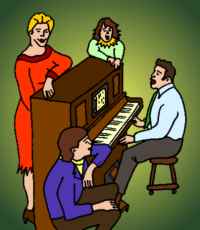 |
The Pianola's Impact on SocietyThe pianola also had an impact on a generation of piano players. Up until this time almost everybody learnt to play the piano as a child, even at the most rudimentary level. However, with the advent of the pianola it was possible to listen to piano music without the skill required to play it. In this way, the pianola brought different styles of music to a broader section of society, increasing the breadth of musical knowledge amongst people who might not otherwise have listened to music. |
Special pianos were also developed to enable faithful recordings to be made of famous pianists of the time. Recording onto special music rolls, the pianists and the technicians were able to remove misplayed notes, add missed notes, change rhythms, and indeed improve the overall performance to create recordings which were actually better than could be played manually.
Thanks to this system it is possible nowadays to reproduce the piano playing of pianists long since dead who were famous in a time before reliable sound recordings could be made.
The Decline of the PianolaPianolas reached their peak popularity in the 1920s. However, the end for the pianola was signalled by the introduction of the gramophone player, the birth of radio and television, the depression of the 1930s, and finally the onset of the Second World War when many painola-making factories closed down or switched to manufacturing for the war effort. There was a brief rebirth in the 1950s and 1960s, with the introduction of electrically powered pianolas in the USA, but in the 1970s attention switched to electrical recording and reproduction of sound, resulting in modern MIDI keyboards and computer-based music. | 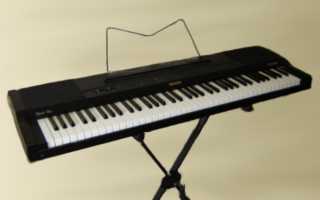 |
Nevertheless, pianolas and their music rolls can still occasionally be found today in antique shops or shops selling second-hand goods.
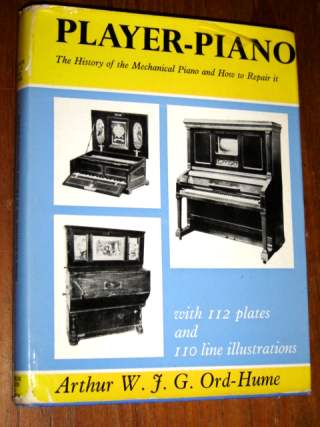 |
Further ReadingI found the book “Player-Piano. The History of the Mechanical Piano and How to Repair it” by Arthur W.J.G. Ord-Hume (published by George Allen & Unwin Ltd, 1970, ISBN 0 04 789003 7) to be invaluable. It goes into the history of the pianola in much more detail than I have above, it explains how different mechanical pianos work, and also it describes how to repair a pianola. |
| << Back to What is a Pianola? | Forward to How does a Pianola work? >> |
| Contact Me Home Page | This page was last updated on 2nd July 2006 |